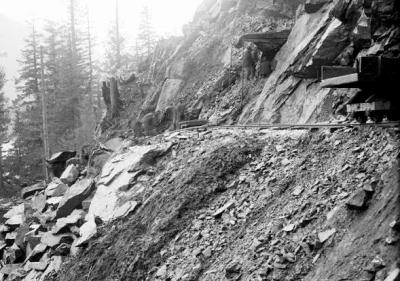 Earlier this week, I pedaled my Rockhopper up the John Wayne Pioneer Trail east of North Bend in search of snow.
Earlier this week, I pedaled my Rockhopper up the John Wayne Pioneer Trail east of North Bend in search of snow.
It's been warmer than normal in the Seattle area so far this winter, and I had to ride 12 to 13 miles up to Carter Creek Camp before I found any white stuff. I didn't have time to explore any further, so I don't know the conditions closer to the now-closed Snoqualmie Tunnel.
Along the way I came across this fallen boulder partially blocking the trail. It looked like a fairly recent fall. I rode my bike up this way in the autumn and don't remember it, and there's some fresh gouge marks in the trail where it looked like it hit.
Roadbed building
Seeing this boulder on the trail, got me to thinking about how work crews for the Chicago Milwaukee and St. Paul Railway company — aka The Milwaukee Road — made this route over and through the Cascades more than a century ago.
 Whoever they were — immigrants, prisoners, men from the surrounding countryside — I must say they did a hell of a job. More than 100 years later the route is still intact, and this is 30 years after the railroad gave up the ghost.
Whoever they were — immigrants, prisoners, men from the surrounding countryside — I must say they did a hell of a job. More than 100 years later the route is still intact, and this is 30 years after the railroad gave up the ghost.
The grade is a gentle 2% up to the Snoqualmie Tunnel, and the terrain around the trailhead at Cedar Falls is wide open. In other places, however, crews chiseled the railroad route right out of the the hillside and cliff faces.
This photo is in the Asahel Curtis collection at the Washington State Historical Society. It was taken in 1906 about 11 miles west of the entrance to the Snoqualmie Tunnel. It's not the exact location of that boulder in the trail, but it shows the hardships facing the engineers and workers.
Looking up the hillside from the fallen boulder, I saw a steep cliff and pale marks where the rock was once attached. Water flow or freeze-thaw must have helped to knock loose this chunk of rock.
It's hard to know how many rocks have come dislodged since the railroad was abandoned. Closer to the tunnel it appears like there's regular maintenance to clear rockslides off the trail.
Milwaukee Road history
A brief history of The Milwaukee Road west of the Cascades tells us the section completed for freight in 1909 and passengers began running in 1911; an alternate route was used before the completion of the Snoqualmie tunnel in 1915.
“The Milwaukee Road was built to be the shortest, fastest, and lowest-cost route to the Northwest, with easier grades and curves than the Great Northern and Northern Pacific. Combined with the lower costs of electric operation, it was able to move freight at lower cost than its competition. …
Electric operation over the Cascades was terminated in 1971. (And in the rest of the system in 1974). Management claimed it could not afford the necessary upgrades. But then it spent the money anyway on new diesel locomotives. The justifications claimed are suspect. The diesel locomotives did not perform quite as well as the electrics, and when the last electric run was made in 1974 diesels cost twice as much to operate as the electric locomotives.
The decline continued. At the end of 1977 the Milwaukee filed for bankruptcy. In 1980 came the final act of self-decapitation: the Milwaukee abandoned everything west of Miles City (on the eastern edge of Montana). “
Visitors
I suppose this boulder crashing to this bike trail must have made a terrifc noise, but I doubt if anyone was around to hear it. There's not a lot of traffic up here this time of year.
On my 25-mile round trip ride, I only encountered three other people — all on foot. I did see one other bike trail mark through the snow, but I had no idea when that would have been made.
Although the weather can be wet and cold, winter and early spring is a good time to visit the rail-trail. Leaves are off a lot of the vegetation at the side of the roadbed, making it easier to spot piles of old railroad ties, rails, and telegraph poles.
And keep your ears open for the chance to hear a falling boulder.

Recent Comments